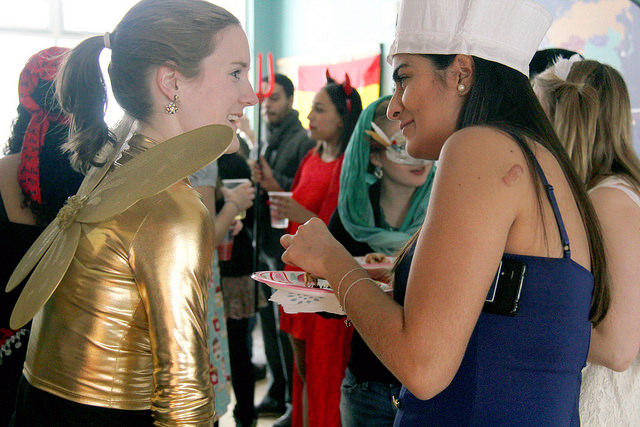International students hold multicultural carnival
Isabel Choinowski (left) and Lorena Souza (right) dressed in costumes and attended the international carnival held in the Max Kade International Wing of North Village on Feb. 21, 2015.
Four international teaching assistants collaborated to organize a carnival celebrating each of their nationalities on Feb. 21, 2015, in the Max Kade International Wing of North Village.
The organizers were each responsible for representing their respective country and chose to do so by compiling music from home and cooking authentic desserts, which attendees spent much of the event dancing to and snacking on.
Rodolpho Camargo, the organizer from Brazil, chose to make chocolate balls for his dessert, spending more than three hours making about 90 of them. He said they were eaten quickly by the 30-40 attendees.
The organizers also invited people to wear costumes to the event, though they were not required. These costumes were not meant to necessarily represent their home countries.
The German organizer, Katharina Schulz, planned a Harry Potter themed costume for the event with several other friends. According to Camargo, costumes are commonly meant to be funny in Brazil and that is what he was expecting at the carnival as well.
“It’s really just to make fun,” he said.
The idea for the carnival involving all four of them originated from Messê Houngnikpo, the French organizer, and Schulz. Schulz was originally planning on holding a carnival in the German house because she was missing the large carnival they regularly hold in her hometown of Cologne, Germany.
“I thought it would be nice to share this experience of celebrating life and friendship with the students here,” Schulz explained. “When Messê, the French TA, heard about my idea, she told me that in France they would celebrate Mardi Gras, which is the French equivalent to our carnival.”
Soon after, they discovered through Camargo and Spanish organizer Hector Lopez Villa that Brazil and Spain also regularly celebrate similar large carnivals and Houngnikpo proposed that they hold the carnival together in order to celebrate all of their cultures.
Elsie Hendricks, ’18, is a European studies major that attended the event. She knew many of the organizers before and appreciated the opportunity to discover similarities between cultures as well.
“I think it’s great to…hear other people’s perspectives,” Hendricks commented. “I’ve been talking to people from different cultures, and we laugh about same things…And I love foreign languages, so I think it’s fascinating.”
Lopez Villa said they heard that another international carnival had been held some years to theirs and that it was a success, but they were unable to find out any details about the carnival, such as which countries were represented, what activities were held and what food was served.
Despite working from scratch, Schulz said her favorite part of the experience was shopping for the supplies.

The four organizers each prepared an authentic dessert from their respective countries.
“Going shopping together was very chaotic and a lot of fun,” she said. “We all had our own shopping lists because each of us prepared an own dish from their countries but we also had a list with stuff that everybody would need. But after a very long time at Walmart and people getting lost…we surprisingly managed to not forget a single item we needed,” she said.
During the organizing, the TAs discovered various similarities between how each of their countries celebrate. According to Schulz, they discovered that the dessert called the Berliner, though originally from Germany and common for their carnivals, is also served in Brazil with a different name. As well, the French and German celebratory parades look nearly identical and the Spanish and Brazilian religious traditions around lent are similar.
Lopez Villa hoped that, in holding the carnival, others could learn as much about their countries as they were while organizing.
“We want to teach our traditions and show an unknown party such as carnival,” Lopez Villa explained. “Maybe is not so well-known in here, but we want to reflect that [which] for us is a big party.”








